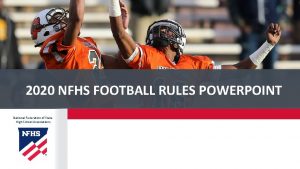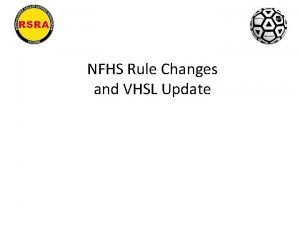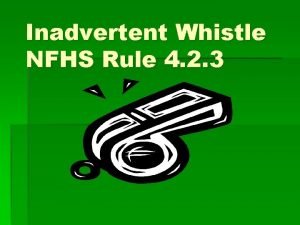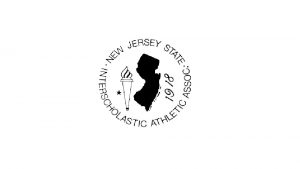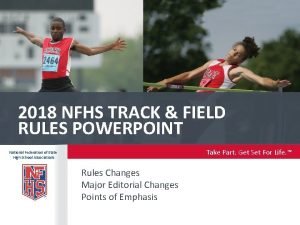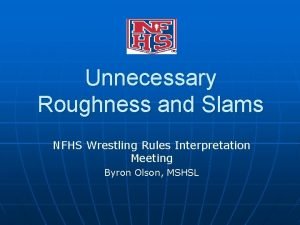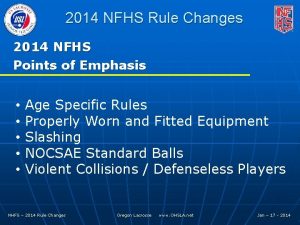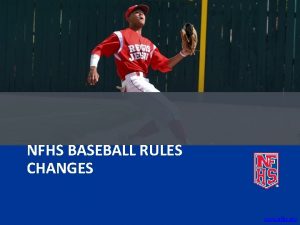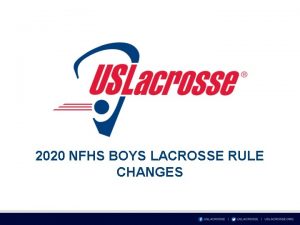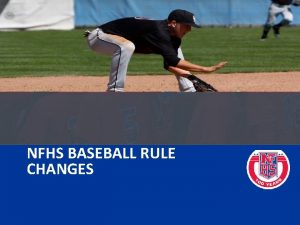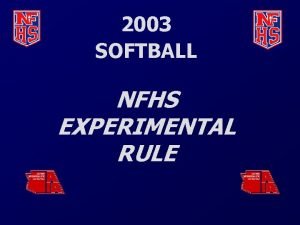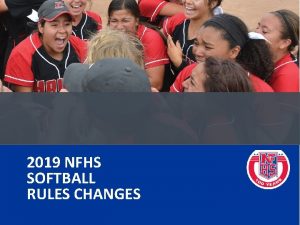NFHS Rule Changes and VHSL Update 2018 2019










- Slides: 10

NFHS Rule Changes and VHSL Update

2018 -2019 in Review 4 -1 -1 a, b: a. The home team shall wear dark jerseys and socks (dark is defined as any color which contrasts with white), and the visiting team shall wear solid white jerseys and solid white socks. Prior to and during the game, jerseys shall be tucked into the shorts, unless manufactured to be worn outside. b. Both socks shall be the same color, with the home team wearing socks of a single dominant color, but not necessarily the color of the jersey and the visiting team wearing solid white sock. If tape or a similar material (stays/ straps) is applied externally to the socks, it must be of similar color as that part of the sock to which it is applied. Rationale: This change allows home teams to wear the school-colored jerseys at home. The change would provide the opportunity for teams to use an alternative color uniform for "special" events, if approved by the state association.

2018 -2019 in Review 4 -1 -1 d, e: d: If visible apparel is worn under the jersey and/or shorts, it shall be of similar length for an individual and a solid liked-color for the team. Rationale: The previous rule caused financial hardships for some players and schools. The rule allows for the purchase of one set of cold-weather undergarments per player. 8 -1 -2: At the moment of the kickoff, all players, except the player taking the kickoff, shall be in their team's half of the field. Players opposing the kicker shall be at least 10 yards from the ball until it is kicked. Rationale: This addition to the rule would permit only the player taking the kickoff to be in the opponent’s half of the field, in order to take the kickoff.

2018 -2019 in Review 12 -8 -1 f, 15 (NEW): A player shall be cautioned (yellow card) for committing an offense against an opponent within his/her team penalty area which denies an opponent an obvious goal -scoring opportunity and the referee awards a penalty kick, if the offense was an attempt to play the ball. 12 -8 -2 d 3, 4 2. A player shall be disqualified (red card) for: (NEW) for attempting to deny an obvious goal-scoring opportunity, and the goal is not scored; or 4. a player commits a foul, inside the penalty area, while not attempting to play the ball, and the goal is not scored. Rationale: This change addresses the issues of denying an obvious goal-scoring opportunity (DOGSO) that occur in the game that places a player and team in double jeopardy when applying a penalty.

2019 -2020 Changes 4 -3: Improperly Equipped Players (18 -1 -1 u) Cautions will not be issued for improperly equipped player(s). If not immediately correctable, improperly equipped player(s) shall be instructed to leave the field of play when the ball next ceases to be in play. The player(s) may be replaced. The removed player(s), if not replaced, may re-enter at the next dead ball only after reporting to an official, who shall be satisfied the player’s equipment and uniform are in order. Play shall not be stopped for an infringement of this rule except that the referee may stop play immediately where there is a dangerous situation. Rationale: The change corrects an injustice. For the far more serious infringement of illegal equipment, the offending team does not play shorthanded. For the less serious offense of improper equipment, they are required to play shorthanded. The change addresses this inequity.

2019 -2020 Changes 7 -4 -3 NEW: The clock shall be stopped when a substitute by the team in the lead is beckoned onto the field in the final five minutes of the second period only. Rationale: Coaches in the lead will make multiple substitutions in the later stages of the match. This tactic is being used as a time-wasting ploy. Adding this rule will help the game to be decided by the players and not a coach who is wasting time when in the lead. These substitutes are usually players from the far side of the field that take more time off the clock. This addition would stop this practice.

2019 -2020 Changes 9 -2 -1: The game is restarted with a drop ball: a. when the ball is caused to go out of bounds by two opponents simultaneously; b. when the ball becomes deflated; c. following temporary suspension of play for an injury or unusual situation and a goalkeeper is not in possession of the ball d. when simultaneous fouls of the same degree occur by opponents. Rationale: This rule changes the awarding of a free kick to a drop ball thereby possibly creating a scoring opportunity for a team undeserving. 9 -2 -3: The ball is dropped by an official from waist level to the ground. Any number of players may contest a dropped ball (including the goalkeepers); a referee cannot decide who may contest a dropped ball or its outcome. Rationale: This addition helps to provide clarity in the application of this rule.

2019 -2020 Changes 9 -2 -5 NEW: ART. 5. . . The ball shall be dropped again if it touches a player before it touches the ground or leaves the field of play after it touches the ground without touching a player. Rationale: This addition helps to avoid confusion and allow the rule to be more equitable under the circumstances. 9 -2 -6 NEW: ART. 6. . . If a dropped ball enters the goal without touching at least two players, play is restarted with a goal kick if it enters the opponent’s goal or a corner kick if it enters the team's own goal. Rationale: This addition helps to avoid confusion and allow the rule to be more equitable under the circumstances. 9 -3: In case of a temporary suspension due to injury or any unusual situation the game shall be started by a drop ball at the point where the ball was when the play was suspended (except as noted in 14 -1 -7), provided the ball was not in the goal area and not in the possession of the goalkeeper. 12 -8 -2 Rationale: This change will eliminate free kick opportunities that often create scoring opportunities that are not deserved.

2019 -2020 Changes 5 -3 -1 d: The officials shall: (d) call out "play on" and, with an underswing of one or both arms, indicate a foul which was observed but shall go unpenalized because penalizing the offending team would give an advantage to the offending team. If the referee applies the advantage, which was anticipated but does not develop at that time, the referee shall penalize the original offense. Rationale: This change permits the use of one arm to signal advantage.

VHSL Update • First cards for coaches. • Indirect profanity and racial slurs – on the rise in the state. • Mercy Rule – will be extended through the playoffs to include the state tournament. Schools and districts can still opt out for regular season. • Ejection reports. – Timely and thorough (5 Ws). – Use NFHS language. – For subsequent cautions (2 nd yellow) identify the cause of both cautions • • • Post-game handshakes/fist bumps with teams. VHSL registration is open (https: //www. whistle. vhsl. org/) Tentative plan for another VHSL face-to-face rules clinic. RSRA HS Clinic – 8 February Rules test will be on line with a review option.
 Nfhs football rule changes 2020
Nfhs football rule changes 2020 Nfhs wrestling rule changes
Nfhs wrestling rule changes Vhsl softball mercy rule
Vhsl softball mercy rule Deferred update and immediate update
Deferred update and immediate update Vhsl whistle
Vhsl whistle 2019 nfhs baseball exam
2019 nfhs baseball exam Nfhs track and field rule book
Nfhs track and field rule book Gartner magic quadrant bi 2018
Gartner magic quadrant bi 2018 Fidelity quarterly market update q1 2018
Fidelity quarterly market update q1 2018 Softball look back rule
Softball look back rule Unnecessary roughness wrestling
Unnecessary roughness wrestling
